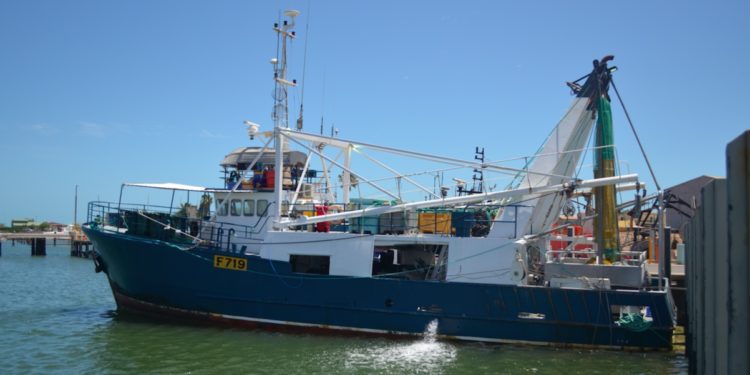Shark Bay Seafoods of South Fremantle in Australia recently installed a Notus Trawlmaster on its deep-water triple rig trawler. The skipper and fleet manager have seen an immediate payback for the system.
Shark Bay Seafoods operates a fleet of trawlers targeting scampi (deep water), prawns and fish, operating in deep water and also on northern prawn in relatively shallow water at depths of 5-60 metres with a Gulf of Mexico-style outrigger configuration. For deep water scampi, triple rig gear is towed two warps, with split bridles leading to a pair doors and a pair of skids.
They installed a Notus Trawlmaster on their triple-rig scampi trawler to wirelessly monitor the spread on each net, door angle and warp/bridle lengths. As the vessel was not dry-docking for some time, a towed hydrophone in a paravane was provided.
Striker targets scampi in 400-500 metre depths off Australia and shoots approximately 1150-2000 metres of warp.
“This is the first sensor sensor system used in this fishery and we knew there had to be opportunities there,” said Notus marketing manager Francis Parrott.
He said that once the sensors had been fitted to Striker’s gear, the results were surprisingly quick as skipper Stormy was able to start making use of the data from the sensors, resulting in a return on investment in the first trip.
“The bottom is typically muddy and they fish two trawl warps using splits that go to two outside doors and two inside skids,” he said.
There are six sensors there, one on each door and two on each sled, so that provides information on the spread of each individual net, which also means that the skipper can see if the gear is al in line, or if one net is overspread or if one of the trawls is underperforming, plus they have the heel angle of each door,” he said.
“We learned a long time ago that the way to go with multi-rig gear is to measure the spread of each net individually,” he said.
Shark Bay Seafoods fleet manager Simon Little has kept a close eye on his return from investing in Notus.
“Our scampi catch has increased 10% due to the Notus sensors and fuel is down 8-9% per trip,” he commented, adding that he and skipper Stormy attribute this to being able to monitor the gear during the entire tow. R03;
A major issue in the fishery is mudding up. The footgear goes into the mud and the trawls eventually become blocked.
“With the Notus sensors you can react right away,” he said.
Being able to increase throttle means that the gear can be cleared away from the mud and the tow can continue as usual, with the towing speed constantly adjusted to ensure the gear is fishing correctly.
“You start at 2.90 knots and then you might go down to 2.50 and up to 3.30, all during the same tow,” he said.









